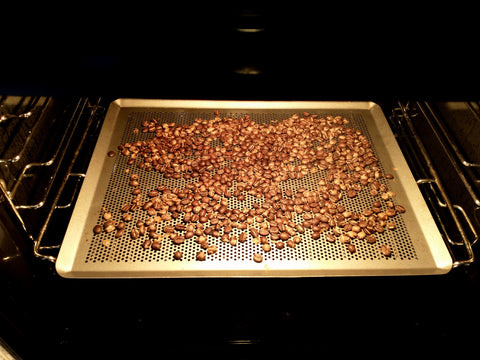
By Rien van Wijk.
Roasting coffee yourself Save me the trouble! That was definitely how I have felt about those coffee nerds that swear by roasting coffee at home. If you want to get the short version of the story, I got converted. For the long story and some tips & tricks, do read on.on.
There is a lot that can be said about coffee; many people see it as one of their favorite beverages, it can kickstart a gray, cold Monday morning and it can be made and enjoyed in many ways. Like wine, you have various varieties but, luckily, we can mainly narrow it down to two: Arabica and Robusta coffee. Arabica coffee is often seen as the Rolls Royce whereas Robusta is mainly a working horse, but there are many exceptions to this rule. Now let us say we have a Columbian coffee bean of an Arabica variety, what does that tell us Well, perhaps not that much. To once more draw a parallel with wine, there is quite a lot of difference in terroir, time of harvest, the ripening process, Nonetheless, in very general terms, coffee from Columbia and the Americas for that matter are often more darker in taste, think for instance chocolate, whereas coffee from the African continent tends to be fruitier with Ethiopian coffees in the most extreme end and Asian coffee more earthy. But here comes the fun part, because if you would buy a ready roasted coffee, much of that taste has been decided for you and since roasting often has taken place weeks or even months before, the freshness is out of the coffee leaving you with a mwah experience. Can you actually roast yourself Well, yes! Plus, you do not need much other than an oven, trial & error, patience and most likely airing out your place a little after a roasting session. Especially that first time when you roast your beans a little too much, you might want to consider checking your smoke alarm in advance It will be a bit of a journey, but a fun one and it will give you the chance to get to taste exactly that coffee you like at the right moment. But roasting is an art and to hit it right, you might be talking seconds so keep a close eye those first few trials.st few trials.
The practical stuff:
Step 1. Preheat your oven to 230 / 240C, not on hot air, just top-bottom heating or similarar
Step 2. Meanwhile, weigh off about 100g of green coffee beans. You could do more at a time, but I like to do it in smaller batches to get a more even roast and get the beans to cool faster
Step 3. Spread out the green coffee beans on a tray, for instance a baking tray with little holes in them that are used for oven fries
Step 4. Keep a close eye, at least the first time. The beans will start to brown after a few minutes with a light, first pop. Do not get tempted to open the oven too often, but you can stir around once every now and then to get a more even roast. Depending on your oven, but perhaps turn the tray around once mid-way, sometimes the oven is slightly warmer in the back compared to the front.
Step 5. Try to aim for a color towards what they call a Full City / Viennese roast, the darker, the faster you will have to be to cool the beans down, so they do not burn. Of course, if you want more of the fruit / spice / earth flavors, you can go with a lighter roast. You can put the beans back if they are still hot, but once they cool down, the beans get cooked which you do not want.
Step 6. Take the beans out, preferably to a sieve under a hood to get rid of some of the fumes and then swirl them around above a sink to get rid of most of the shells.
Voila, there you have it, your own freshly roasted coffee!
Now you only have to grind it, brew it and drink it, enjoy!

Extra tips:
Remember that part about coffee from different parts of the world having slightly different tastes Use it to your advantage and try to mix and match to your taste!!
If you have a manual grinder at home, try different settings of coarseness until you hit the spot for your French press, espresso,…
When it says somewhere that the beans are meant for espresso, this is not written in stone. You can just as well use them for a French press, filter, just make sure you grind them coarse enough. Or perhaps use a bit of those beans and some lighter roasted beans. When I make 0.5L of coffee or two good cups, I most often go for 10g of espresso beans and 15-20g of something else.se.
Ow, and do take notes the first rounds when you are roasting, some beans only need minutes whereas others may need well over a quarter of an hour. Just so you do not mix it up and end up with charcoal and a blaring smoke alarm.…).
And when you are really getting the hang of, try to do a cupping session yourself so you can taste the differences between various coffees straight on, you will be surprised how big the differences are! As a bonus it can help you narrow down the coffee you like=)
By Rien van Wijk

